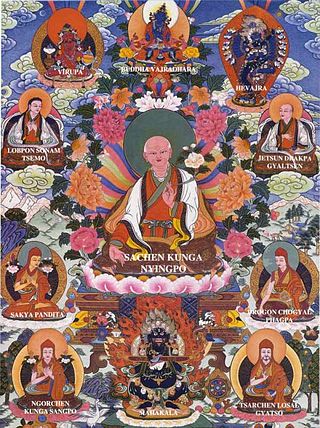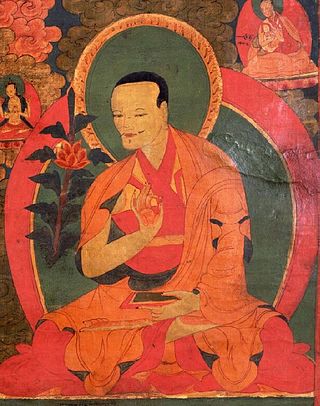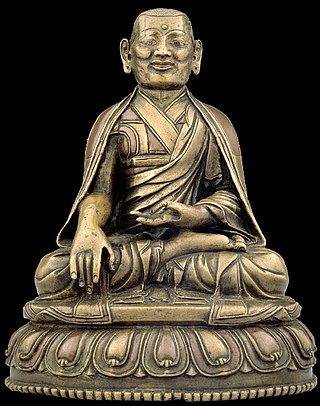Related Research Articles

The Sakya school is one of four major schools of Tibetan Buddhism, the others being the Nyingma, Kagyu, and Gelug. It is one of the Red Hat Orders along with the Nyingma and Kagyu.
Drogön Chogyal Phagpa, was the fifth leader of the Sakya school of Tibetan Buddhism. He was also the first Imperial Preceptor of the Yuan dynasty, and was concurrently named the director of the Bureau of Buddhist and Tibetan Affairs, serving during the reign of Kublai Khan. Historical tradition remembers him as the first vice-ruler of Tibet under the Yuan emperor as well as one of the Five Sakya patriarchs. Although this is historically disputed, he played a very important political role.

Buddhism is the largest religion in Mongolia practiced by 51.7% of Mongolia's population, according to the 2020 Mongolia census. Buddhism in Mongolia derives much of its recent characteristics from Tibetan Buddhism of the Gelug and Kagyu lineages, but is distinct and presents its own unique characteristics.

Sakya PanditaKunga Gyeltsen was a Tibetan spiritual leader and Buddhist scholar and the fourth of the Five Sakya Forefathers. Künga Gyeltsen is generally known simply as Sakya Pandita, a title given to him in recognition of his scholarly achievements and knowledge of Sanskrit. He is held in the tradition to have been an emanation of Manjusri, the embodiment of the wisdom of all the Buddhas.

Sakya Monastery, also known as Pel Sakya is a Buddhist monastery situated in Sa'gya Town (ས་སྐྱ་), Sa'gya County, about 127 kilometres (79 mi) west of Shigatse in the Tibet Autonomous Region. The monastery is considered as the seat of the Sakya school of Tibetan Buddhism.

Gorampa Sonam Senge was an important philosopher in the Sakya school of Tibetan Buddhism. He was the author of a vast collection of commentaries on sutra and tantra whose work was influential throughout Tibetan Buddhism. Gorampa is particularly known for his writings on madhyamaka philosophy, especially his critique of the madhyamaka views of Tsongkhapa and Dolpopa. Gorampa defended the mainly anti-realist interpretation of madhyamaka held by the Sakya school.
Igor de Rachewiltz was an Italian historian and philologist specializing in Mongol studies.
Weldon South Coblin, Jr. is an American Sinologist, linguist, and educator, best known for his studies of Chinese linguistics and Tibetan.

There were several Mongol invasions of Tibet. The earliest is the alleged plot to invade Tibet by Genghis Khan in 1206, which is considered anachronistic; there is no evidence of Mongol-Tibetan encounters prior to the military campaign in 1240. The first confirmed campaign is the invasion of Tibet by the Mongol general Doorda Darkhan in 1240, a campaign of 30,000 troops that resulted in 500 casualties. The campaign was smaller than the full-scale invasions used by the Mongols against large empires. The purpose of this attack is unclear, and is still in debate among Tibetologists. Then in the late 1240s Mongol prince Godan invited Sakya lama Sakya Pandita, who urged other leading Tibetan figures to submit to Mongol authority. This is generally considered to have marked the beginning of Mongol rule over Tibet, as well as the establishment of patron and priest relationship between Mongols and Tibetans. These relations were continued by Kublai Khan, who founded the Mongol Yuan dynasty and granted authority over whole Tibet to Drogon Chogyal Phagpa, nephew of Sakya Pandita. The Sakya-Mongol administrative system and Yuan administrative rule over the region lasted until the mid-14th century, when the Yuan dynasty began to crumble.

Mongolian literature is literature written in Mongolia and/or in the Mongolian language. It was greatly influenced by and evolved from its nomadic oral storytelling traditions, and it originated in the 13th century. The "three peaks" of Mongol literature, The Secret History of the Mongols, Epic of King Gesar and Epic of Jangar, all reflect the age-long tradition of heroic epics on the Eurasian Steppe. Mongol literature has also been a reflection of the society of the given time, its level of political, economic and social development as well as leading intellectual trends.
Leonard W.J. van der Kuijp is a Dutch professor of Tibetan and Himalayan Studies and former chair of the Department of Sanskrit and Indian Studies at Harvard University.

Tibet under Yuan rule refers to the Mongol-led Yuan dynasty's rule over Tibet from 1244 to 1354. During the Yuan dynasty rule of Tibet, the region was structurally, militarily and administratively controlled by the Mongol-led Yuan dynasty of China. In the history of Tibet, Mongol rule was established after Sakya Pandita got power in Tibet from the Mongols in 1244, following the 1240 Mongol conquest of Tibet led by the Mongol general with the title doord darkhan. It is also called the Sakya dynasty after the favored Sakya school of Tibetan Buddhism.
Buddhists, predominantly from India, first actively disseminated their practices in Tibet from the 6th to the 9th centuries CE. During the Era of Fragmentation, Buddhism waned in Tibet, only to rise again in the 11th century. With the Mongol invasion of Tibet and the establishment of the Mongol Yuan dynasty (1271–1368) in China, Tibetan Buddhism spread beyond Tibet to Mongolia and China. From the 14th to the 20th centuries, Tibetan Buddhism was patronized by the Chinese Ming dynasty (1368–1644) and the Manchurian Qing dynasty (1644–1912) which ruled China.
Jamyang Donyo Gyaltsen, in orthographic spelling Jam dbyangs don yod rgyal mts'an, was a ruler of Sakya which had a precedence position in Tibet under the Yuan dynasty. He reigned from 1341 until his death in 1344.

Sönam Gyaltsen, the Sakya Lama Dampa was a ruler of the Sakya school of Tibetan Buddhism, which had a precedence position in Tibet under the Yuan dynasty. He is considered the greatest Sakya scholar of the 14th century and served as ruler for a short term in 1344–1347.
Lotro Gyaltsen, in orthographic spelling bLo gros rgyal mts'an, was a ruler of Sakya, which had a precedence position in Tibet under the Yuan dynasty. He reigned from 1347 to 1365; however, Sakya lost its influence in Central Tibet in 1354. In that way he was the last Sakya lord before the ascension of the new Phagmodrupa Dynasty.
Yeshe Rinchen was a Tibetan Imperial Preceptor (Dishi) at the court of the Mongol-led Yuan dynasty. He hailed from Sakya, the foremost monastic regime in Tibet in this period, and held the title from 1286 to 1291.
Drakpa Odzer was a Tibetan Imperial Preceptor (Dishi) at the court of the Mongol-led Yuan dynasty of China. He hailed from Sakya which was the foremost monastic regime in Tibet in this period. He held the post from 1291 to his death in 1303.
Kunga Lekpa Jungne Gyaltsen was a Tibetan Imperial Preceptor (Dishi) at the court of the Mongol-led Yuan dynasty. He belonged to the abbot family Khon of Sakya which had a precedence position in Tibet in this era. He held the dignity from 1327 to 1330.
Prince Tsangma was the eldest son of King Sadnalegs of Tibet. In Bhutanese traditions, he is held to be the first King of the eastern region.
References
- 1 2 Kara, Györgi (2009). Dictionary of Sonom Gara's Erdeni-yin Sang A Middle Mongol Version of the Tibetan Sa Skya Legs Bshad. Mongol - English - Tibetan. Brill. p. XVII-XXI; 265. ISBN 978-90-04-18224-0.
- 1 2 Monumenta Serica: Journal of Oriental Studies. Vol. 32–33. Monumenta Serica Institute. 1976. p. 496 https://books.google.com/books?id=sqNwAAAAMAAJ.
{{cite magazine}}: Missing or empty|title=(help) - ↑ Inner Asia. Vol. 1–2. White Horse Press. 1999. p. 15.
- ↑ Suomen Itämainen Seura (1976). Studia Orientalia Volume 45. Finnish Oriental Society. p. 188.
- ↑ Jackson, David P. (1997) The Entrance Gate for the Wise (Section III): Saskya Pandita on Indian and Tibetan Traditions of Pramana and Philosophical Debate. Wien: Arbeitskreis für Tibetisch und Buddhistiche Studien Universiteit, p. 2.
- 1 2 "Mongolian literature". Britannica. Archived from the original on 18 May 2021. Retrieved 18 May 2021.